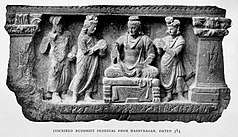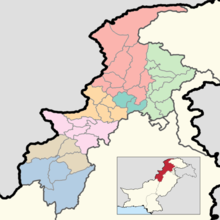Charsadda District, Pakistan
Charsadda District (Pashto: چارسدہ ولسوالۍ, Urdu: ضِلع چارسدہ) is a district in Peshawar Division of Khyber Pakhtunkhwa province in Pakistan. Prior to its establishment as a separate district in 1998, it was a tehsil within Peshawar District.[2] Pashtuns make up majority of the population of the district. District headquarter is town of Charsadda, which was part of the Peshawar ex-metropolitan region.
Chārsadda District | |
|---|---|
 Location in the province of Khyber Pakhtunkhwa | |
| Country | |
| Province | |
| Headquarters | Charsadda |
| Area | |
| • District | 996 km2 (385 sq mi) |
| Population | |
| • District | 1,616,198 |
| • Density | 1,600/km2 (4,200/sq mi) |
| • Urban | 270,175 |
| • Rural | 1,346,023 |
| Time zone | UTC+5 (PST) |
| Number of Tehsils | 3 |
Overview and history
The district lies between 34-03' and 34-38' north latitudes and 71-28' and 71-53' east longitudes. Charsadda is located in the west of the Khyber Pakhtunkhwa and is bounded by Malakand District to the north, Mardan district to the east, Nowshera and Peshawar districts to the south and the Mohmand Agency of the Federally Administered Tribal Areas to the west. The district covers an area of 996 square kilometers.
Charsadda was once part of the kingdom of Gandhara, however around 516 BC Gandhara became part of the seventh satrapy or province of the Achaemenid Empire and paid tribute to Darius the Great of Persia, until its overthrow by Alexander the Great in the 4th century BC.
After the death of Alexander in 323 BC the Indian Emperor Chandragupta Maurya rose to power and brought Gandhara under his sway. According to a popular tradition, Emperor Ashoka built one of his stupas there. This stupa was mentioned by the famous Chinese Buddhist pilgrim Hieun Tsang, who visited in 630, according to him Po-Lu-Sha (as he called the stupa) was 2.5 miles (4.0 km) in circumference.
A Brahminical temple to the east and a monastery to the north which according to Buddhist legends was the place where Buddha preached the Law. The name Gandhara disappeared after Mahmud of Ghazni conquered the area and converted it to Islam in 1026.
Bactrian Greeks
This area was also ruled by the Bactrian Greeks between 250–125 BC which was succeeded by the Indo-Greek Kingdom who ruled until 10 AD.
Shabqadar
Shabqadar is a small town in Charsadda tehsil 17 miles (27 km) north west of Peshawar. A fort was built here by the Sikhs called Sharkargarh. The town was burnt by Mohmands in 1897 It has since been rebuilt.
Bibi Syeda Dheri
Bibi Syeda Dheri is a site half a mile to the north of Umarzai village in Charsadda tehsil here is a mound 60 ft (18 m) high. Believed to be the site of the stupa erected to commemorate the conversion by Lord Buddha of goddess Hariti who used to devour children of the locality. There is also a shrine of a lady saint Bibi Syeda.
Shar-i-Napursan
Shar-i-Napursan is an archaeological site in Charsadda tehsil near the village Rajjar Excavations have unearthed two distinct settlements of the Buddhist period and two of the Muslim period. Coins of Manander, Hermaeous and Kanishka have been unearthed.
Palatu Dheri

Palatu Dheri is another archaeological site near Charsadda tehsil. A mile from Shar-i-Napursan A mound which contains the remains of a stupa, which according to Hieun Tsiang, was built by one Deven and some coins which connect them both to the first century AD have been unearthed Other finds include the image of the goddess Kalika-devi. Three inscribed jars, which were presented by some laymen to "the Community of the Four Quarters", are now in the Peshawar Museum.
Charsadda
The city of Charsadda originally known as Pushkalavati is first mentioned in the Hindu epic story the Ramayana.
Bala Hisar of Charsadda
Bala Hisar was excavated twice by the head of the Archaeological Survey of India, Sir John Marshall, in 1902 and by Sir Mortimer Wheeler in 1958. According to South Asian Archaeology Research Group of Bradford University Wheeler suggested that Bala Hisar "was founded by the Persians in the sixth century BC as a colony guarding the eastern edge of their empire".[4]
Demographics
The population of Charsadda district, according to the 2017 census, is 1,616,198.[5] The population of the district over the years is shown in the table below.[6]
| Census Year | Population | Rural Area | Urban Area |
|---|---|---|---|
| 1951 | 282,618 | 233,233 | 49,385 |
| 1961 | 364,088 | 288,330 | 75,758 |
| 1972 | 513,193 | 408,129 | 105,064 |
| 1981 | 630,811 | 498,977 | 131,834 |
| 1998 | 1,022,364 | 829,513 | 192,851 |
| 2017 | 1,616,198 | 1,346,023 | 270,175[7] |
The population counted in the 1998 census was 1,022,000, of which 19% were urban.[8] The predominant language is Pashto, spoken natively by 99.4% of the population.[9]
Administration
The district is administratively subdivided into 3 Tehsils comprising a total of 58 Union Councils:[10]
| Tehsil | No. of Union Councils |
|---|---|
| Charsadda | 34 |
| Tangi | 12 |
| Shabqadar | 12 |
National Assembly Seats
The district is represented in the National Assembly by two MNAs who represent the following constituencies:[11]
| Constituency | MNA | Party |
|---|---|---|
| NA-7 Charsadda-I | Fazal Mohammad | PTI |
| NA-8 Charsadda-II | Anwar Taj | PTI |
Provincial Assembly Seats
The district is represented in the Provincial Assembly by six MPAs who represent the following constituencies:[12]
| Constituency | MPA | Party |
|---|---|---|
| PK-17 Charsadda-I | Fazle Shakoor Khan | PTI |
| PK-18 Charsadda-II | Sultan Mohammad Khan | PTI |
| PK-19 Charsadda-III | Shakeel Bashir khan | National Awami Party |
| PK-57 Charsadda-IV | Khalid Khan | PTI |
| PK-21 Charsadda-V | Sikandar Hayat Khan | Qaumi Watan Party |
| PK-22 Charsadda-VI | Mohammad Arif | Pakistan Tehreek-e-Insaf |
See also
- Bacha Khan
- Babrra massacre
References
- "DISTRICT AND TEHSIL LEVEL POPULATION SUMMARY WITH REGION BREAKUP: KHYBER PAKHTUNKHWA" (PDF). Pakistan Bureau of Statistics. 2018-01-03. Archived from the original (PDF) on 2018-04-24. Retrieved 2018-04-23.
- PCO 1998, p. 1.
- Problems of Chronology in Gandharan Art p.37
- "Bradford University - The Bala Hisar of Charsadda". Archived from the original on 2007-12-13. Retrieved 2007-06-16.
- "Pakistan Tehsil Wise Census 2017 [PDF]" (PDF). www.pbscensus.gov.pk. Archived from the original (PDF) on 2017-11-07. Retrieved 2017-11-29.
- "AREA & POPULATION OF ADMINISTRATIVE UNITS BY RURAL/URBAN: 1951-1998 CENSUSES (PDF)" (PDF). www.pbs.gov.pk. Retrieved 2017-12-02.
- "Archived copy" (PDF). Archived from the original (PDF) on 2017-08-29. Retrieved 2017-09-01.CS1 maint: archived copy as title (link)
- PCO 1998, p. 25.
- PCO 1998, p. 29.
- Tehsils & Unions in the District of Charsada - Government of Pakistan Archived March 22, 2008, at the Wayback Machine
- Members of the National Assembly of Pakistan
- Members of the Khyber Pakhtunkhwa Assembly
Bibliography
- 1998 District census report of Charsadda. Census publication. 68. Islamabad: Population Census Organization, Statistics Division, Government of Pakistan. 2000.
